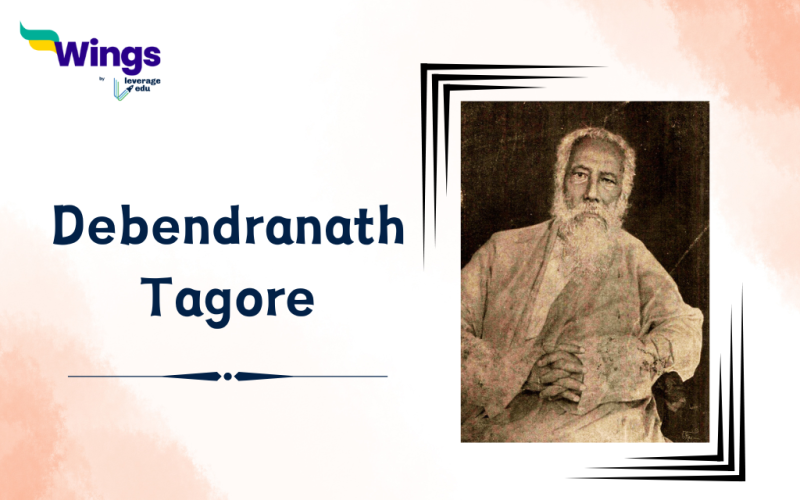The father of Rabindranath Tagore, Debendranath Tagore was a religious reformer and a Hindu philosopher, writer, etc. He came to be known during the Bengal Renaissance period when he vehemently opposed social evils which were prevalent in Indian society. He got associated with Brahmo Samaj and Tattwabodhini Sabha and worked in developing Brahmo dharma. Read more about the biography of Debendranath Tagore in this blog and his contribution to Indian society.
| Overview of Debendranath Tagore | |
| Name | Maharishi Debendranath Tagore |
| Birth | May 15, 1817 (Kolkata, India) |
| Wife | Saradasundari Devi |
| Profession | Social Reformer and activist |
| Founder | Tattwabodhini Sabha, Brahmo Samaj, etc. |
| Died | 19 January 1905, aged 87. |
Biography of Debendranath Tagore
Table of Contents [show]
Born into wealth and privilege in Calcutta (Kolkata) on 15th May 1817, he was the oldest son of successful businessman” Prince Dwarkanath Tagore” and Digambari Devi.
- He developed a deep interest in religion and spirituality from a young age.
- This interest was further fueled by a profound experience beside his grandmother’s deathbed and his discovery of a page from the Isha Upanishad.
- After having home tuition, he went on to Anglo-Hindu College in Calcutta to pursue higher studies in the year 1827.
- Having received a traditional education in Sanskrit, Persian, English, and Western philosophy, he was influenced by Hindu scriptures and Eastern/Western philosophy to seek a reformed Hinduism.
- He started practising law but gave it up soon to focus on religious pursuits.
- After marrying Shardasundari Devi, they both had 15 children, one of them was Rabindranath Tagore, the famous writer and Nobel Prize winner.
Ideology of Debendranath Tagore
Debendranath Tagore, a critic of blind faith in Vedic texts, emphasized the importance of rationality and critical thinking.
- He argued that people should question the Vedas’ validity and relevance, rather than accepting them as absolute truth.
- Debendranath believed in the power of individual interpretation over dogmatic adherence, encouraging people to use their intellects to understand spiritual concepts.
- He translated the Upanishads to make complex philosophical ideas more accessible, especially to those who didn’t know Sanskrit.
- Debendranath also worked to spread Hindu spirituality beyond caste boundaries, founding a college and organizing public lectures that focused on personal spiritual experiences over ritualistic practices.
Also Read – Keshab Chandra Sen: Social Reformer, Brahmo Samaj & More
Debendranath Tagore’s Career and Contribution to Indian History
Debendranath Tagore was an important person in the Brahmo Samaj movement, founded by Raja Ram Mohan Roy in 1828. He joined Roy in his mission to promote monotheism and reject idol worship. Here is a timeline of his contribution to Indian history –
| Career Stage | Contribution |
| Founder of Tattvaranjini Sabha (later renamed Tattwabodhini Sabha) in 1839. | Founded Tattwabodhini Sabha (Society for the Seeker of Truth) in 1839. Promoted the purification of Hinduism through philosophical inquiry and teachings of the Upanishads. |
| Founder of Tattwabodhini Patrika | Published a journal that advocated for the rationalisation of Brahmo doctrines, female education, widow remarriage, and denounced polygamy. |
| Founder of Brahmo Samaj in 1843 along with Raja Ram Mohan Roy | It was a monotheistic movement, that established a spiritual fraternity for prayer and meditation, leading a significant shift from the Tattwabodhini Sabha. |
| Brahmo Samaj rejected idolatry, and the caste system, and emphasized individual spiritual experience. | |
| However, due to a schism between Keshab Chandra Sen and the Samaj, the organization was disintegrated and Debedranath Tagore’s Samaj was called Adi Brahmo Samaj. | |
| Founder of Tatwabodhini Pathshala in 1844 | Established Tatwabodhini Pathshala or Theological school, a school to train young teachers to teach Brahmo religion |
| Founded Santiniketan in 1863 | Debendranath Tagore founded Santiniketan in 1863, originally known as Bhubandanga, in Bolpur. The name Santiniketan, meaning “abode of peace,” was chosen for its calming effect on Tagore. |
As he was the torch bearer in spreading Brahmoism throughout India, he earned the title “Maharshi” (great soul) given by Radhakanta Dev.
Books by Debendranath Tagore
Some of his famous works include –
| Books | Year |
| Brahma Dharmo Grantho | 1851 |
| Atmatatto Bdya | 1852 |
| Brahma Dharmer Mot O Biswas | 1860 |
| Kalikata Bramha Samajer Baktrita | 1862 |
| Gyan O Dharmer Unnati | 1893 |
| Porolo O Mukti | 1895 |
Maharshi Debendranath Tagore took his last breath on 19 January 1905 in Calcutta, aged 87. The legacy and ideologies of Debendranath Tagore greatly influenced Hindu spirituality. He translated the Upanishads into a language more people could understand, breaking down caste barriers in Hinduism. His emphasis on personal spiritual growth over rituals changed how people practised their faith. His son, Rabindranath Tagore, established “Visva-Bharati University” to carry on his work in education and spirituality in India.
Relevant Blogs
This was all about the biography of Debendranath Tagore. If you want to know more about other Famous Personalities then visit our General Knowledge page!
 One app for all your study abroad needs
One app for all your study abroad needs















 45,000+ students trusted us with their dreams. Take the first step today!
45,000+ students trusted us with their dreams. Take the first step today!
